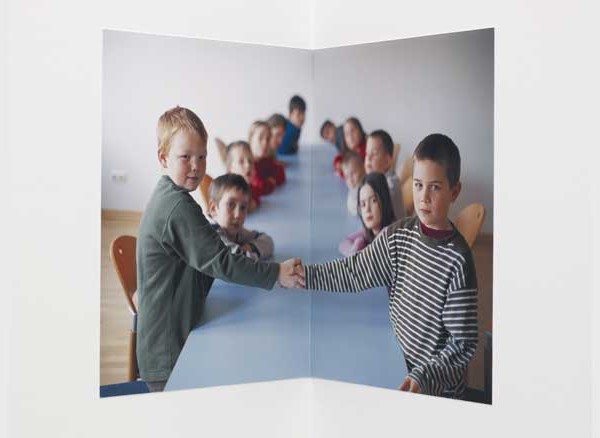


Installation
Inkjet art print on Hahnemuhle paper
Edition 1/5 + 2 A.P.
21 x 15.5 x 16 cm
Acquisition in 2016
The installation Tomorrows (Handshake) shows a photograph taken by the artist of children in a school setting. Symmetrically arranged around a long table, a group of children look directly at the viewer. In the sharpness of the foreground, we see two of them shaking hands. The photograph is folded to fit into the corner of two walls in the space in which it is hung, accentuating the symmetrical effect and guiding the viewer’s perception of the image.
Roman Ondák took this shot in the city of Erlauf, Austria. Located a hundred or so kilometres from Vienna, it was the theatre of a crucial yet little-known episode of European history. In 1945, American and Soviet generals exchanged a handshake in this town, marking the unofficial end of the Second World War. Invited to work around the historical context of this city, the artist chose to work with young children, whom he photographed in a variety of settings. Taking as his inspiration, old press clippings and the imaginary evoked by the various official situations he selected, including for example an inauguration, the artist took a series of images, according to the principle of re-enactment, i.e. the fact of ‘replaying’ or ‘re-enacting’ history. Stripping away the contextual details, as well as the trappings of the historical scenes and pictures, in his work the artist retained merely their attitudes and gestures. The choice to embody their protagonists with young children—future citizens of the city—affirms the necessity of transmission, pedagogy and sharing. For Tomorrows (Handshake), the artist purposely questioned the children about their perception of the future of relations with the United States, which they then translated, uninstructed, through the gesture of the handshake. The work is the evocation of a past reality, revisited and reinstated in the present and projected into the future, thereby challenging the notions of memory and monument. The sense of solemnity, specific to the gesture of the handshake, is almost contradicted by the presence of these young actors, and leads to a kind of phenomenon of reversal or duplication of reality, the motif of the double also being present in the spatialization of the photograph, ‘folded’ into a corner. The archive seems to come to life, grandiloquence dissolves into banality and the fears of yesterday give way to hope.